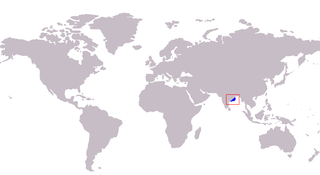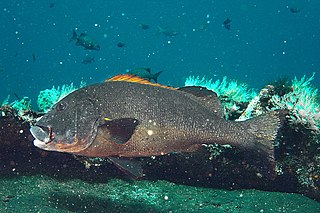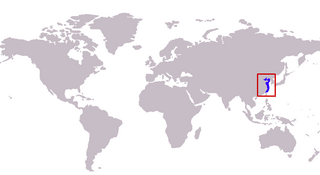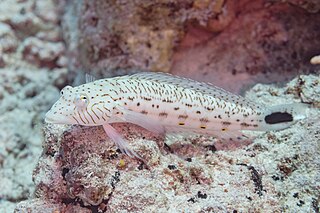
The Asian arowana comprises several phenotypic varieties of freshwater fish distributed geographically across Southeast Asia. While most consider the different varieties to belong to a single species, work by Pouyaud et al. (2003) differentiates these varieties into multiple species. They have several other common names, including Asian bonytongue, dragonfish, and a number of names specific to the different color varieties.

The grey-headed fish eagle is a fish-eating bird of prey from South East Asia. It is a large stocky raptor with adults having dark brown upper body, grey head and lighter underbelly and white legs. Juveniles are paler with darker streaking. It is often confused with the lesser fish eagle and the Pallas's fish eagle. The lesser fish eagle is similar in plumage but smaller and the Pallas's fish eagle shares the same habitat and feeding behaviour but is larger with longer wings and darker underparts. Is often called tank eagle in Sri Lanka due to its fondness for irrigation tanks.

The smoothback angelshark is an angelshark of the family Squatinidae found in the eastern Atlantic and Mediterranean.
Hemibagrus wyckii is a species of catfish of the family Bagridae. It is occasionally called the crystal-eyed catfish or black devil catfish.
Breitensteinia is a genus of catfishes of the family Akysidae. It includes three species.

The Sunda forktail is a species of bird in the family Muscicapidae. It is endemic to Indonesia, where it is restricted to the islands of Java and Sumatra. Its natural habitat is boulder strewn streams in tropical moist montane forest from 600–2000 m. More rarely the species occurs closer to sea level. The species is common in Sumatra, but is rarer in Java, where the white-crowned forktail is more common.

Acrochordonichthys is a genus of catfishes of the family Akysidae. It includes ten species.
Encheloclarias is a genus of airbreathing catfishes endemic to Southeast Asia.
Encheloclarias tapeinopterus is a species of airbreathing catfish endemic to Indonesia where it is only known from Bangka and Sumatra. This species reaches a length of 12.4 cm TL.

The club-foot whiting, also known as the club-foot sillago or thicken-spined sillago, the only member of the monospecific genus Sillaginopodys, is a coastal marine fish of the smelt whiting family Sillaginidae that inhabits a wide range including west Africa, India and the northern Indonesian Archipelago. The species is unique in the morphology of the pelvic spine and fin, making identification of the species easier than most of its relatives. The species is of minor commercial importance, taken by seine net and marketed fresh throughout its range.

The smallmouth scad, is a species of tropical marine fish in the jack family Carangidae. The species is endemic to northern Australia, inhabiting primarily inshore waters. It is similar to other scads in the genus Alepes, and is distinguished by a well-developed posterior adipose eyelid, as well as fin membrane spotting and gill raker counts. It is not a large species, with the maximum length reported to be 29.5 cm. It feeds primarily on a variety of small invertebrates, and is of very minor economic importance.

The soringa whiting, also known simply as soringa or soringa sillago, is a poorly known species of coastal marine fish of the smelt-whiting family, Sillaginidae. The Soringa whiting is known exclusively from the east coast of India, inhabiting shallow inshore environments, particularly sandy substrates. S. soringa was first described in 1982 by Dutt and Sujatha, with the taxonomic status of the species was questioned by Roland McKay in his review of the Sillaginidae, with similar features to S. asiatica suggesting it is a senior synonym of the latter.

The estuarine whiting, also known as Vincent's whiting, is a species of benthic inshore marine fish of the smelt-whiting family, Sillaginidae. The estuarine whiting is very similar in appearance to the northern whiting, Sillago sihama, and as such was mistaken for the latter until 1980, when R.J. McKay identified the species based primarily on swimbladder morphology. The estuarine whiting is distributed along both the east and west coasts of India, primarily inhabiting the muddy substrates of estuaries. The species is locally important to fisheries in India, and is recognized as having aquaculture potential.

The longfin trevally, also known as the longfin kingfish, longfin cavalla or armed trevally, is a species of inshore marine fish in the jack family, Carangidae. The species is common in tropical to subtropical waters of the Indo-Pacific, ranging from South Africa in the west to Japan in the east, typically inhabiting inshore reefs and bays. The species is easily distinguished by its elongate dorsal and anal fin lobes and filamentous dorsal rays, as well as its scaleless breast. Longfin trevally are pelagic predators, taking a variety of small fish, cephalopods and crustaceans, and reach sexual maturity at around 21 cm. The species has a maximum known length of 57 cm and weight of 3.5 kg. The longfin trevally has a very complex taxonomic history which is closely intertwined with another currently valid species, Carangoides ciliarius, which may yet prove to be synonymous. Longfin trevally are of minor importance to fisheries throughout their range and are considered good table fish, and are occasionally taken by anglers.

Plectorhinchus albovittatus, the two-striped sweetlips or giant sweetlips, is a species of marine ray-finned fish, a sweetlips belonging to the subfamily Plectorhinchinae, part of the grunt family Haemulidae. It is native to the Indian Ocean and the western Pacific Ocean.

The cocinero, also known as the barred jack and striped jack, is a species of small marine fish classified in the jack family, Carangidae. The cocinero is distributed through the tropical eastern Pacific Ocean, ranging along the west American coastline from Baja California in the north to Peru in the south. It is a pelagic species, inhabiting the upper water column in both coastal and offshore oceanic waters, occasionally making its way into estuaries. The species may be identified by its colouration, having 8 or 9 incomplete dark vertical stripes on its sides, with scute and gill raker counts also diagnostic. It is small compared to most other species of Caranx, reaching a length of 37 cm in total. The cocinero is a predatory fish, taking small fishes, crustaceans, and various benthic invertebrates in shallower waters. Little is known of the species' reproductive habits. The cocinero is of moderate importance to fisheries along the west coast of South America, and the species has been used in aquaculture trials. It is taken by various netting methods and by spear, and is sold fresh, dried, and salted at market.

Euthynnus lineatus, the black skipjack tuna or black skipjack, is a species of ray-finned bony fish in the family Scombridae. It belongs to the tribe Thunnini, better known as the tunas.

The Chinese sillago is a species of inshore marine fish in the smelt whiting family Sillaginidae, described in 2011. The species is known only to inhabit the coastal waters of China, primarily in estuarine tidal flats near Wenzhou, Zhejiang Province. The Chinese sillago was described in 2011 based on morphological and DNA barcode analysis of several specimens. Several detailed anatomic features distinguish it from other sillaginids, with Sillago parvisquamis its closest relative based on phylogenetic analysis. Nothing is known of the ecology or importance to fisheries of the Chinese sillago.

Hoplichthys, the ghost flatheads, is a genus of marine ray-finned fishes native to the Indian and Pacific Oceans. This genus is the only member of the family Hoplichthyidae.

Parapercis hexophtalma, the speckled sandperch, is a species of marine bony fish in the family Pinguipedidae, found in the western Indo-Pacific Ocean. It was first described by the French naturalist Georges Cuvier in 1829. There are several synonyms, some of which represent misspellings of the original name, and others which were given to female fish, at the time thought to be a separate species.















